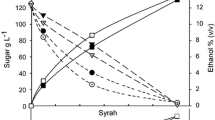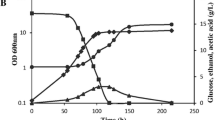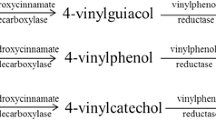Abstract
Brettanomyces bruxellensis is the main microorganism responsible for the production of off-flavours in wine. Studies have been carried out in synthetic cultures using p-coumaric acid for the production of vinyl and ethylphenols. The results obtained have been extrapolated to authentic wine, but there is no evidence that this correlation will be correct. We studied the behaviour of B. bruxellensis native strain LAMAP L2480 in authentic wine and in a synthetic medium with a chemical composition similar to the authentic wine used in this study (basal synthetic wine + pH, ethanol and hydroxycinnamic acid concentrations of commercial wine). In some assays, B. bruxellensis has been studied using media containing 100 mg L−1 p-coumaric acid, so we also used the same concentration added to the authentic and synthetic wines. The microorganism showed better growth in authentic wine, regardless of the presence of p-coumaric acid. In the case of synthetic wine, the addition of p-coumaric acid caused a delay in yeast growth and an increase in the production of volatile phenols. The coumarate decarboxylase activity did not show any difference regardless of the media and the presence of p-coumaric acid. Vinylphenol reductase showed higher activity when a higher concentration of p-coumaric acid was added in synthetic wine, but no change was observed in authentic wine.



Similar content being viewed by others
References
Barata A, Pagliara D, Piccininno T, Tarantino F, Ciardulli W, Malefeito-Ferrerira M, Loureiro V (2008) The effect of sugar concentration and temperature on growth and volatile phenol production by Dekkera bruxellensis in wine. FEMS Yeast Res 8:1097–1102
Baranowski JD, Davidson PM, Nagel CW, Branen AL (1980) Inhibition of Saccharomyces cerevisiae by naturally occurring hidroxycinnamates. J Food Sci 45:592–594
Beltran G, Novo M, Guillamon JM, Mas A, Rozes N (2008) Effect of fermentation temperature and culture media on the yeast lipid composition and wine volatile compounds. Int J Food Microbiol 121:169–177
Benito S, Palomero F, Morata A, Calderón F, Suarez-Lepe JA (2009) Factors affecting the hydroxycinnamate decarboxylase/vinylphenol reductase activity of Dekkera/Brettanomyces: application for Dekkera/Brettanomyces control in red wine making. J Food Sci 74:M15–M22
Chambel A, Viegas CA, Sa-Correia I (1999) Effect of cinnamic acid on the growth and on plasma membrane H+-ATPase activity of Saccharomyces cerevisiae. Int J Food Microbiol 50:173–179
Chatonnet P, Dubourdieu D, Boidron J, Pons M (1992) The origin of ethylphenol in wine. J Food Sci 60:165–178
Chatonnet P, Dubourdieu D, Boidron JN (1995) The influence of Brettanomyces/Dekkera sp. Yeasts and lactic acid bacteria on the ethylphenol content of red wines. Am J Enol Vitic 46:463–468
Chatonnet P, Viala C, Dubourdieu D (1997) Influence of polyphenolic components of red wine on the microbial synthesis of volatile phenols. Am J Enol Vitic 48:443–448
Coulon J, Perello MC, Lonvaud-Funel A, De Revel G, Renouf V (2010) Brettanomyces bruxellensis evolution and volatile phenols production in red wines during storage in bottles. J Appl Microbiol 108:1450–1458
Deak T (2007) Handbook of food spoilage yeasts, 2nd edn. CRC Press, Florida
Degrassi G, De Laureto P, Bruschi CV (1995) Purification and characterization of ferulate decarboxylase from Bacillus pumilus. Appl Environ Microbiol 61:326–332
Dias L, Dias S, Sancho T, Stender H, Querol A, Malfeito-Ferreira M (2003) Identification of yeasts isolated from wine-related environments and capable of producing 4-ethylphenol. Food Microbiol 20:567–574
Edlin D, Narbad A, Dickinson J, Lloyd D (1995). The biotransformation of simple phenolic compounds by Brettanomyces anomalus. FEMS Microbiol Lett 125:311–315
Edlin D, Narbad A, Gasson M, Dickinson J, Lloyd D (1998) Purification and characterization of hydroxycinnamate decarboxylase from Brettanomyces anomalus. Enzym Microb Technol 22:232–239
Fleet G (2003) Yeast interactions and wine flavour. Int J Food Microbiol 86:11–22
Ganga MA, Salinas F, Ravanal C, García V, Carrasco C, Martínez C, Saavedra J (2011) Cinnamic acid, ethanol and temperature interaction on coumarate decarboxylase activity and the relative expression of the putative cd gene in D. bruxellensis. Electron J Biotech 15:5–11
Godoy L, Martínez C, Carrasco N, Ganga MA (2008) Purification and characterization of a p-coumarate decarboxylase and a vinylphenol reductase from Brettanomyces bruxellensis. Int J Food Microbiol 127:6–11
Godoy L, Martinez C, Saavedra J, Combina M, Ganga MA (2009) Study of the coumarate decarboxylase and vinylphenol reductase activities of Dekkera bruxellensis (anamorph Brettanomyces bruxellensis) isolates. Lett Appl Micrbiol 48:452–457
Godoy L, Varela J, Martínez C, Ganga MA (2013) The effect of hydroxycinnamic acids on growth and H+-ATPase activity of the wine spoilage yeast Dekkera bruxellensis. Afr J Microbiol Res 7:5300–5305
Grbin P, Henschke P (2000) Mousy off-flavour production in grape juice and wine by Dekkera and Brettanomyces yeasts. Aust J Grape Wine Res 6:255–262
Harris V, Ford CM, Jiranek V, Grbin PR (2009) Dekkera and Brettanomyces growth and utilisation of hydroxycinnamic acids in synthetic media. Appl Microbiol Biotechnol 81:1117–1127
Harris V, Jiranek V, Ford C, Grbin P (2010) Inhibitory effect of hydroxycinnamic acids on Dekkera spp. Appl Microbiol Biotech 86:721–729
Loureiro V (2000) Spoilage yeasts in food and beverage: characterisation and ecology for improved diagnosis and control. Food Res Int 33:247–256
Mira NP, Teixeira MC, Sa-Correia I (2010) Adaptive response and tolerance to weak acids in Saccharomyces cerevisiae: a genome-wide view. OMICS J Integr Biol 14:525–540
Morata A, Gomez-Cordoves MC, Colomo C, Suarez-Lepe J (2005) Cell wall anthocyanin adsorption by different Saccharomyces strains during the fermentation of Vitis vinifera L. cv Graciano grapes. Eur Food Res Technol 220:341–346
Petrozziello M, Asproudi A, Guaita M, Borsa D, Motta S, Panero L, Bosso A (2014) Influence of the matrix composition on the volatility and sensory perception of 4-ethylphenol and 4-ethylguaiacol in model wine solutions. Food Chem 149:197–202
Romano A, Perello MC, de Revel G, Lonvaud-Funel A (2008) Growth and volatile compound production by Brettanomyces/Dekkera bruxellensis in red wine. J Appl Microbiol 104:1577–1585
Ross K, Beta T, Arntfield S (2009) A comparative study on the phenolic acids identified in dry beans using HPLC as affected by different extraction and hydrolysis methods. Food Chem 113:336–344
Saavedra D, Godoy P, Narváez C, Zepeda S, Urrutia M, Brevis P, Reyes E (2005) Brettanomyces, un contaminante en nuestras viñas. Cienc Trab 7:93–96
Salameh D, Brandam E, Medawar W, Lteif R, Strehaiano P (2008) Highlight on the problems generated by p-coumaric acid analysis in wine fermentations. Food Chem 107:1661–1667
Stratford M, Plumridge A, Archer DB (2007) Decarboxylation of sorbic acid by spoilage yeasts is associated with the PAD1 gene. Appl Environ Microbiol 73:6534–6542
Sturm E, Rojo M, Ciclic I, Ramirez M, Combina M (2010) Development of a model wine media to evaluate Dekkera bruxellensis growth in mimic wine conditions. Biocell 34, MIC-22
Suárez R, Suárez-Lepe JA, Morata A, Calderón F (2007) The production of ethylphenols in wine by yeasts of the genera Brettanomyces and Dekkera: a review. Food Chem 102:10–21
Valdes H, Romero J, Saavedra A, Plaza A, Bubnovich V (2009) Concentration of noni juice by means of osmotic distillation. J Membr Sci 330:205–213
Wedral D, Shewfelt R, Frank J (2010) The challenge of Brettanomyces in wine. LWT-Food Sci Technol 43:1474–1479
Wines of Chile (2013) http://www.winesofchile.org/
Acknowledgments
This work was developed as part of the following grants: a DICYT- USACH-081471CL FONDECYT-11100700- and Millennium Nucleus for Fungal Integrative and Synthetic Biology (MN-FISB) 120043.
Author information
Authors and Affiliations
Corresponding author
Rights and permissions
About this article
Cite this article
Coronado, P., Aguilera, S., Carmona, L. et al. Comparison of the behaviour of Brettanomyces bruxellensis strain LAMAP L2480 growing in authentic and synthetic wines. Antonie van Leeuwenhoek 107, 1217–1223 (2015). https://doi.org/10.1007/s10482-015-0413-7
Received:
Accepted:
Published:
Issue Date:
DOI: https://doi.org/10.1007/s10482-015-0413-7




